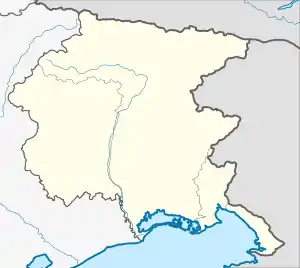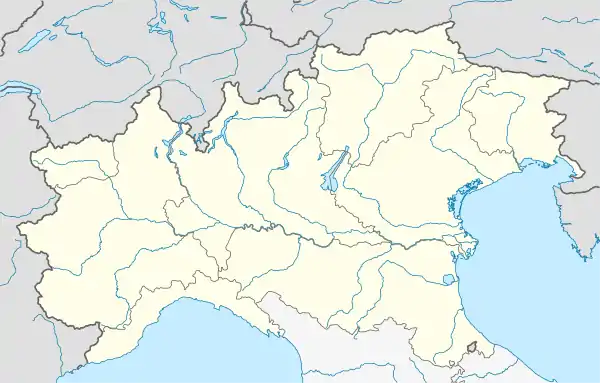Gorizia Centrale railway station
Gorizia Centrale railway station (Italian: Stazione di Gorizia Centrale; German: Görz Südbahnhof (former name)) is the main station serving the town and comune of Gorizia, in the autonomous region of Friuli-Venezia Giulia, northeastern Italy.
Gorizia Centrale | |
|---|---|
 The main entrance. | |
| Location | Piazzale Martiri per la Libertà d'Italia 34170 Gorizia GO Gorizia, Gorizia, Friuli-Venezia Giulia Italy |
| Coordinates | 45°55′58″N 13°36′27″E |
| Operated by | Rete Ferroviaria Italiana Centostazioni |
| Line(s) | Udine–Trieste Gorizia-Nova Gorica railway Gorizia–Ajdovščina (closed 1993) |
| Distance | 32.682 km (20.308 mi) from Udine |
| Train operators | Trenitalia |
| Connections |
|
| Other information | |
| Classification | Silver |
| History | |
| Opened | 1 October 1860 |
| Location | |
 Gorizia Centrale Location in Friuli-Venezia Giulia  Gorizia Centrale Location in Northern Italy  Gorizia Centrale Location in Italy | |
Overview
Opened in 1860, the station forms part of the Udine–Trieste railway, and is also a junction station for an international branch line linking Gorizia with Ajdovščina in nearby Slovenia.
The station is currently managed by Rete Ferroviaria Italiana (RFI). However, the commercial area of the passenger building is managed by Centostazioni. Train services to and from the station are operated by Trenitalia. Each of these companies is a subsidiary of Ferrovie dello Stato (FS), Italy's state-owned rail company.
Location
Gorizia Centrale railway station is situated at Piazzale Martiri per la Libertà d'Italia, at the southwestern edge of the city centre.
History
The station was opened on 1 October 1860, upon the inauguration of the Cormons–Galleria section of the Udine–Trieste railway.[1] Located at that time in the territory of the Austrian Empire, the station then had the dual name of Görz/Gorizia and was operated by the Imperial Royal Privileged Southern Railway Company of Austria, Venice and central Italy (German: Kaiserlich königliche privilegierte Südbahngesellschaft).
In 1902, the station became a junction station for the branch line to Ajdovščina (Italian: Aidussina; German:Haidenschaft), built by the Austrian imperial society Localbahn Görz-Haidenschaft, which awarded management rights to the Südbahngesellschaft.
Four years later, upon the opening of the Jesenice-Trieste railway (part of the network of railway lines known as the Transalpine Railway), the station took on the dual designation of Görz Südbahnhof/Gorizia Meridionale, to distinguish it from its counterpart on the new line, the Görz Staatsbahnhof/Gorizia stazione delle ferrovie dello stato (now the Nova Gorica railway station). The two systems were connected by a short rail link using part of the branch line to Ajdovščina.
Under the Treaty of Saint-Germain-en-Laye (1919), the two stations went to the Kingdom of Italy, and the FS became the operator of both. Over the next twelve years, the station on the Udine-Trieste railway changed its name several times: initially it retained only its Italian name Gorizia Meridionale, then it became Gorizia Campagnuzza, and since 1923 it has been Gorizia Centrale.[2]
Features
Inside the station, there are ticket windows, ticket machines, a lounge, a bar, a newsagency, and passport photo machines.
All the regional trains travelling on the Udine-Trieste railway stop at the station, and some of them terminate there.
Train services
The movement of passengers is about 1.4 million people a year, which means that the station is the fifth busiest station in Friuli-Venezia Giulia in terms of numbers of passengers.[3]
The station is served by the following service(s):
- Night train (Intercity Notte) Rome - Bologna - Venice - Udine - Trieste
- Express services (Regionale Veloce) Venice - Treviso - Udine - Gorizia - Trieste
- Regional services (Treno regionale) Venice - Treviso - Udine - Gorizia - Trieste
| Preceding station | Trenitalia | Following station | ||
|---|---|---|---|---|
toward Roma Termini | Intercity Notte | toward Trieste Centrale |
||
toward Venezia Santa Lucia | Treno regionale | toward Trieste Centrale |
||
toward Venezia Santa Lucia | Treno regionale | toward Trieste Centrale |
See also
References
- Alessandro Tuzza; et al. "Prospetto cronologico dei tratti di ferrovia aperti all'esercizio dal 1839 al 31 dicembre 1926" [Chronological overview of the features of the railways opened between 1839 and 31 December 1926]. Trenidicarta.it (in Italian). Alessandro Tuzza. Archived from the original on 24 June 2009. Retrieved 26 November 2010.
- Decreto Ministeriale 30 agosto 1923
- "Flussi Annui nelle 103 Stazioni" [Annual flows at the 103 stations]. Centostazioni website (in Italian). Centostazioni. Archived from the original on 9 February 2010. Retrieved 30 November 2010.
External links
| Wikimedia Commons has media related to Gorizia Centrale train station. |
This article is based upon a translation of the Italian language version as at November 2010.
